Want to jump straight to the answer? The best website monitoring service for most people is StatusCake.
Website monitoring services help you track uptime, page speed, and real-world performance so you can catch issues before customers do. Whether your site is brand new or has been live for years, monitoring is essential for protecting revenue, SEO, and user trust.
The Best Website Monitoring Services
- StatusCake — Fastest URL testing intervals (as quick as 30 seconds)
- Monitive — Best for swift, escalating downtime notifications
- Uptime Robot — Best genuinely free website monitoring
- Pingdom — Best page-speed and performance monitoring at scale
- Uptrends — Best for flexible Real User Monitoring (RUM) add-ons
- Host Tracker — Most unique extras (DNS blacklist checks, Google Ads pause)
You don’t need to spend a fortune to get excellent coverage—many sites start on a solid free plan, then add paid features as traffic and complexity grow.
Below I’ve included a mix of free and paid tools so you can match capabilities and price to your needs.
StatusCake — Fastest URL Testing Intervals

More than 100,000 users—including Microsoft, Netflix, FanDuel, and JetBrains—trust StatusCake to keep sites available and fast. It monitors from ~43 locations across 30 countries to reduce false alarms from regional issues.
The standout feature is speed: StatusCake offers check intervals as fast as 30 seconds on its Business plan, far quicker than the one- to five-minute intervals you see elsewhere.
Pricing is straightforward. The Business plan is about $66.66/month and unlocks 30-second checks, larger monitor limits, team tools, and advanced reporting. The Superior plan is about $20.41/month with one-minute checks—great for most small to midsize sites. There’s also a Free plan for basic needs (10 monitors, five-minute checks).
Depending on your plan, you’ll get:
- Uptime checks with multi-location verification
- Page speed monitoring and performance trends
- SSL and domain expiration monitoring
- Server monitoring and status pages
- Integrations (Slack, PagerDuty, Teams, and more), alerts, and exportable reports
If you’re on the Business plan, you also get multi-user tools. The Free plan tests every five minutes and includes a basic page-speed monitor—perfect for simple sites that don’t need advanced options yet.
Monitive — Best for Swift Downtime Notifications
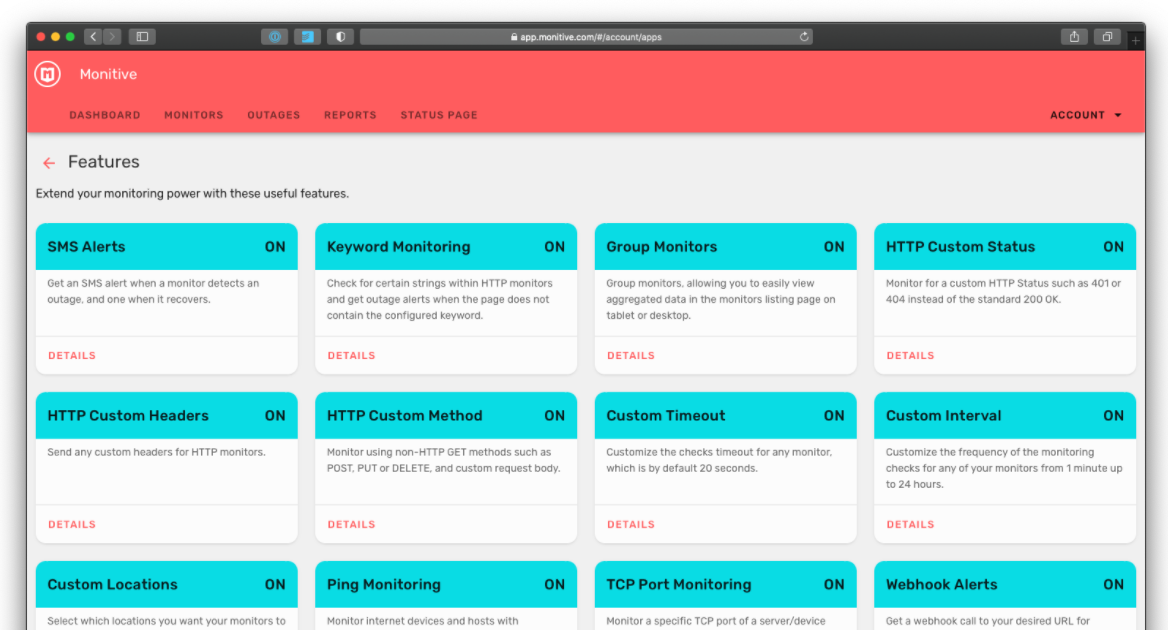
If your main job is to coordinate a response when things break, Monitive is excellent. Add your sites to its dashboard and it escalates notifications automatically so outages never slip by.
When downtime is detected, Monitive can notify you by email immediately, then escalate to SMS, messaging apps, and even phone calls if the site remains down—so the right person can jump in fast.
Beyond basic uptime, Monitive includes useful extras:
- Custom timeout thresholds and maintenance windows
- HTTP(S), Ping, and TCP checks from global locations
- Multi-user access
- Alerts via Slack, PagerDuty, Telegram, Pushover, and more
Free forever monitors one page at 10-minute intervals with email alerts and weekly/monthly uptime summaries. Pro starts around $7/month and lets you monitor 2–500 pages at 1-minute intervals, adding SMS/phone alerts, status pages, API monitoring, long-term logs, and integrations.
If you want clean, reliable uptime monitoring with urgent, escalating notifications, get started with Monitive today.
Uptime Robot — Best Free Website Monitoring Service
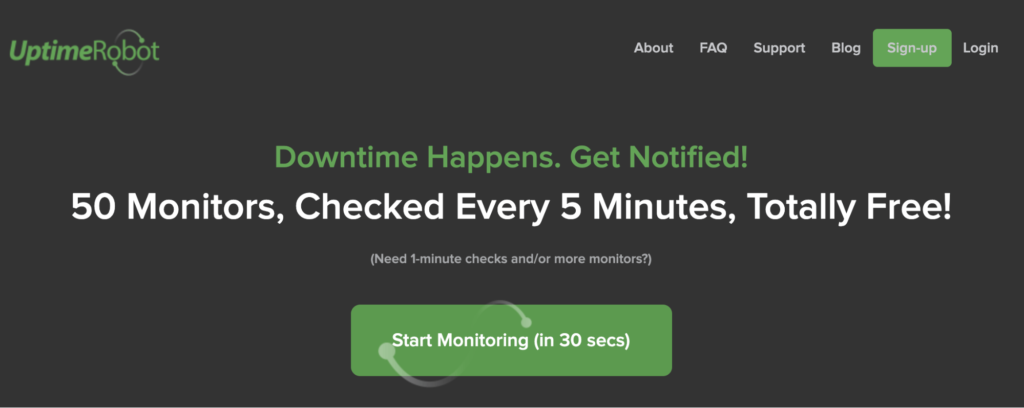
Uptime Robot offers one of the strongest free plans around: 50 monitors checked every five minutes, plus keyword, ping, port, and heartbeat/cron monitors.
Paid plans accelerate detection and add more power. Solo and Team plans bring 60-second checks, advanced maintenance windows, DNS/SSL/domain monitoring, incident management, integrations (Slack, Teams, Telegram, webhooks, and more), and customizable status pages. Enterprise adds 30-second checks and higher monitor counts.
You can also customize alerting to avoid noise—only trigger notifications after, say, one or two minutes of continuous downtime, and require multi-location confirmation before an alert fires.
Pingdom — Best Page Speed & Performance Monitoring
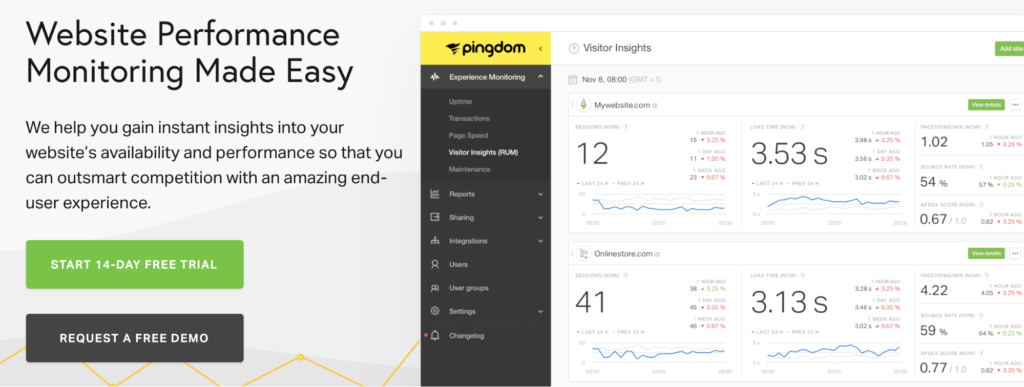
Pingdom is known for outstanding page-speed testing and robust synthetic monitoring. It also offers Real User Monitoring (RUM) for real-world performance insights and an incident workflow that routes alerts to the right on-call person.
Highlights include:
- Global uptime monitoring with root-cause details
- RUM for user-centric metrics like page load and UX trends
- Synthetic transaction testing for flows like search, login, and checkout
- Page speed monitoring with ongoing budgets and alerts
- API access and integrations for automation
Pingdom now uses a mix-and-match pricing model—choose the number of uptime checks, advanced checks (transactions), SMS credits, and RUM pageviews you need. That makes it easy to right-size costs, from small sites to enterprise estates.
You can optionally bundle Pingdom with infrastructure, APM, and log monitoring from the same vendor for full-stack visibility.
Uptrends — Best for Real User Monitoring Add-Ons
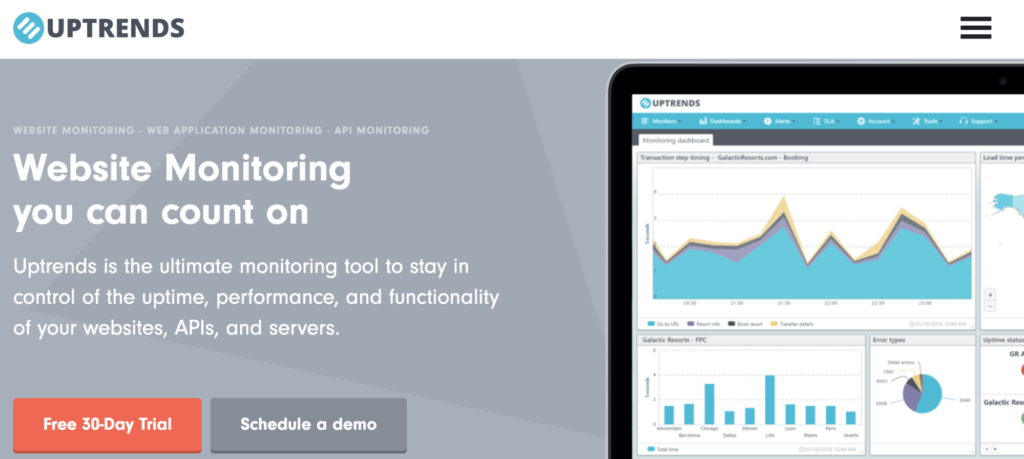
Uptrends is a flexible, cloud-based platform with website, API, and transaction monitoring—and a particularly nice approach to RUM that you can add as needed. Its pricing is modular, so you only pay for the products and credits you need (uptime/availability, multi-step API, synthetic transactions, browser monitoring, and RUM).
Uptrends also shines on education and support, with a deep knowledge base, an academy, and responsive guidance to help you get more from your monitors.
Host Tracker — Most Unique Features
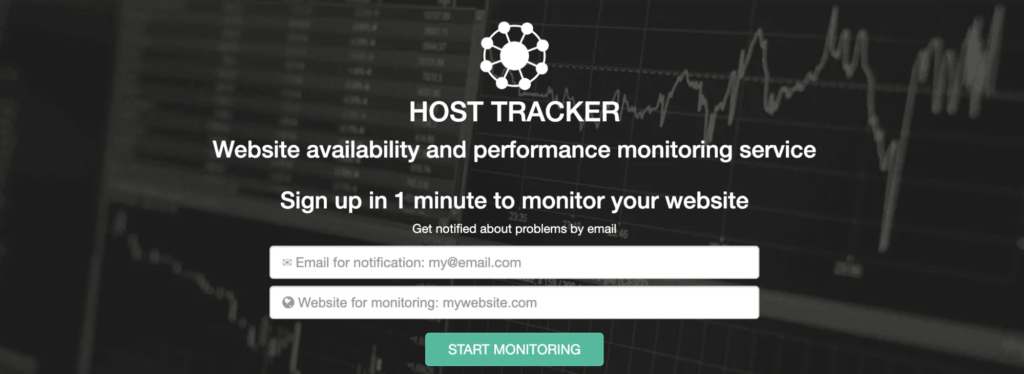
Host Tracker packs in distinctive extras beyond standard uptime checks. In addition to downtime alerts, SSL checks, and performance monitoring, it can scan DNS blacklists for your IP/domain and notify you if you’re listed so you can remediate quickly.
One standout: Host Tracker can automatically pause your Google Ads if your site goes down, then resume when you’re back online—so you’re not paying for clicks that can’t convert.
Plans are accessible: Webmaster from about $9.90/month (first-year promo), Business from about $18.25/month, and Enterprise around $75–$99/month depending on term, all with a free trial. Host Tracker runs checks from 100+ global locations and is used by hundreds of thousands of sites.
How to Find the Best Website Monitoring Service
All monitors track the basics, but the best match depends on your stack, traffic, and incident workflow. Use these criteria to separate “works” from “works best.”
Map your needs: Decide what matters most—fastest detection, synthetic user flows, RUM for Core Web Vitals, API checks, or budget-friendly coverage. Then choose the plan that hits those goals without paying for extras you won’t use.
URL Monitoring Frequency
Intervals determine how quickly you’ll catch an outage. Many services default to 1–5 minutes; premium plans offer 30–60 seconds. For revenue-critical sites, aim for 60-second checks (or 30-second when possible). For blogs and small sites, five minutes is often fine.
To reduce false positives, use multi-location confirmation and require a short consecutive-failure threshold (e.g., two failures across two regions) before firing alerts.
Server & Infrastructure Monitoring
Some website monitors include server monitoring; others don’t. If you’re troubleshooting resource issues, look for CPU, memory, disk, process/service, and network checks so you can correlate app errors with infrastructure spikes. If your website monitor doesn’t cover this, pair it with your host’s tools or a lightweight agent.
Real User Monitoring (RUM)
RUM collects anonymized data from actual visitors, surfacing issues you won’t see with purely synthetic tests—like slow third-party scripts, specific device/network bottlenecks, and layout shifts that hurt UX. Use RUM alongside page-speed budgets to improve Core Web Vitals and conversion rates.
Synthetic Transactions
For ecommerce, SaaS signups, and gated content, record key user journeys (login, search, add-to-cart, checkout, payment callbacks). Choose a tool with an easy recorder, version control for scripts, and screenshots/filmstrips so you can pinpoint exactly where a flow breaks.
Alerting & Collaboration
Make sure alerts go to the right people via Slack/Teams/PagerDuty, with escalations, on-call schedules, and maintenance windows to pause alerts during planned work. Public status pages help you communicate proactively during incidents.
Price
Free plans comfortably cover personal sites and MVPs. For businesses, expect affordable entry tiers in the $5–$30/month range for 1-minute checks and integrations, with higher-frequency checks, transactions, and RUM priced by volume. Many vendors now use modular pricing so you only pay for the monitors and pageviews you need.
The Top Website Monitoring Services in Summary
Monitoring reveals where your site struggles, protects SEO, and reduces support pain. With the right setup—fast checks, smart alerting, synthetic journeys, and RUM—you’ll fix issues sooner and build a faster, more reliable experience.
StatusCake, Monitive, Uptime Robot, and Pingdom are rock-solid picks for most people. Uptrends is great if you want à-la-carte RUM and synthetic options. Host Tracker adds unique features like DNS blacklist monitoring and auto-pausing ads during outages.
